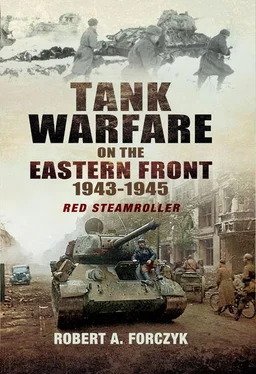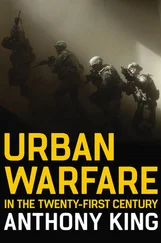Soviet tankers were astounded to discover in 1945 that German gunnery ranges included both moving and pop-up targets. {17} German tank gunnery employed a number of different drills, employing armour-piercing ( Panzergranate ) against stationary, frontal tank-size targets and moving targets moving obliquely to the tank. Crews were also trained to use high-explosive ( Sprenggranate ) rounds against anti-tank guns and machine-guns against troop targets. While the ammunition used for training was limited and often not the same calibre that would be used by the crew in actual combat, a panzer crew in 1943 could expect to fire the equivalent of a basic load of ammunition during the course of training. After hard experience in Russia, German tank gunnery training also emphasized low-visibility and night training scenarios to accustom crews to the reality that combat did not always occur under the best conditions.
By 1943, most of the junior panzer officers were former enlisted men or NCOs who were awarded reserve commissions after attending Panzertruppenschule I or II. The term ‘reserve officer’ suggests a callow, hastily-trained officer with limited ability to lead troops in the field, but Germany’s wartime reserve officers were anything but ‘90-day wonders’. Rather, these men usually had the advantage of prior combat service, often in tanks, although some candidates came from other branches as well. One example was 20-year-old Leutnant der Reserve (d.R.) Otto Carius, who had served as a tank loader in the opening weeks of Operation Barbarossa , then was promoted to Unteroffizier in August 1941 before receiving his commission in 1942. By the time he was assigned to schwere Panzer-Abteilung 502 as a platoon leader in January 1943, Carius was a veteran tanker and would ably prove himself as a leader at the front. {18}
The introduction of the Tiger tank in late 1942 and the Panther tank in early 1943 forced the Germans to make major adjustments to their tank training programmes. Even veteran panzer crews and the unit-level mechanics required extensive training on the new vehicles, since they were so different from the existing Pz III and Pz IV medium tanks. A special unit, Panzer-Ersatz-Abteilung 500, was established at Paderborn to train all Tiger tank crews and mechanics; this unit could train 24 crews at a time. However, the demand for Tigers at the front was so extreme in 1943 that most crews passed through the training course in 4–6 weeks, which was barely sufficient. In March 1943, the Panther Lehrgänge (Training Course) was established at Erlangen, which provided convenient technical support from the manufacturer MAN in Nurnberg. Manoeuvre and gunnery training for Panther crews was conducted at Grafenwöhr, but like the Tiger training, the Panther training was rushed. Important items, such as training crews how to recover a 45-or 54-ton tank on the battlefield, received minimal time. Since the Germans intended to convert one Panzer-Abteilung in each Panzer-Division to the Panther, there was great pressure to push crews rapidly through the training, which would soon cause major problems in combat. Furthermore, neither the Waffen-SS nor the Luftwaffe had their own training structure for Panzertruppen and simply borrowed the Heer’s – which seriously interfered with the introduction of the Panther in 1943.
Impact of Fuel and Spare Parts Shortages
By 1943, shortages of fuel and spare parts at the front were seriously reducing the operational readiness of Germany’s Panzer-Divisionen. The Third Reich went to war with the Soviet Union with completely inadequate fuel reserves and exhausted nearly half its stockpile during Operation Barbarossa in 1941. Although Germany made great efforts to increase synthetic fuel production, during 1942 monthly military consumption of fuel exceeded production in seven out of 12 months. At the end of 1942, Germany’s reserve stockpile of motor gasoline was down to 313,000 tons, equivalent to less than three months’ worth. By 1943, minus civilian consumption, Germany was producing about 136,000 tons of motor gasoline per month and consuming about 120,000 tons – enabling a slight increase in the strategic reserve. In addition, about 47,500 tons of diesel oil per was produced per month. {19} Thus, Germany’s military machine was living a hand-to-mouth existence that left little or no room for unanticipated losses of production due to enemy action, such as Allied bombing. Nor could the Germans really afford to continue to mount large-scale manoeuvre operations like Barbarossa and Blau without further depleting their reserves; the new norm shifted to mount short-objective operations measured in weeks, not months.
German fuel logistics were measured in Verbrauchssatz (abbreviated to V.S.); 1 V.S. was the amount of fuel required to move every vehicle in a unit 100km. German doctrine stated that a Panzer-Division should possess at least 4 V.S. prior to the start of offensive operations. The amount of fuel in 1 V.S. varied considerably depending upon the type of vehicles in use; the German tanks of 1941–42 were much more economical than the heavier tanks and self-propelled guns of 1943–45. In 1941, 1V.S. of fuel for a Panzer-Division was roughly 150,000 litres (measured in cubic metres, cbm, with 1 cbm equivalent to 1,000 litres) or 150 cbm or 111 tons of fuel. Yet while it only required between 340–360 litres of fuel to move a Pz III or Pz IV 100km, it required 720 litres for the Panther and 711 litres for the Tiger. Likewise, equipping the Panzer-Division with more tracked vehicles such as self-propelled artillery and more SPW halftracks nearly doubled the amount of fuel required for operations. Increased armament and increased armoured protection resulted in much more fuel being consumed, which became something of a vicious circle for the Panzerwaffe.
In order to keep some kind of strategic fuel buffer, panzer units training in Germany and Western Europe were given only modest amounts of fuel for training. Basic driver training on the Pz I was essentially unaffected since this obsolete light tank was fairly fuel efficient, but it had a major impact on the Panther and Tiger conversion courses. Drivers were given less training time on these fuel hogs in order to save fuel for the front, but this meant that many of the new Panther drivers did not get sufficient cross-country experience. Units sent to train in France were shocked to find that there was no stockpile of fuel and ammunition available there for training. One newly-formed unit, the schwere Panzerjäger-Abteilung 560, equipped with the new Hornisse tank destroyer, was sent to France to train in April 1943 but received no fuel and only ten rounds of 8.8cm ammunition per company. Soon afterwards, the unit deployed to the Eastern Front with no driver training and only a familiarization fire for the gunners.
An additional complication with fuel supplies was actually getting the fuel to the forward areas in the Soviet Union, which was a laborious process and fraught with risks from bad weather, partisan activity and Soviet air attacks on rail centres and fuel storage areas. In the first winter on the Eastern Front, about 80 per cent of the Deutsche Reichsbahn’s (DR) trains suffered mechanical failures in the extreme cold, which reduced daily supply deliveries to one-third of required demand. Due to the destruction of railroad bridges over the Dnepr River, the Germans were also forced to send trains on a circuitous route to reach Heeresgruppe Süd during the 1942 campaign. The situation eased a bit in 1943, since the Germans were no longer gaining significant amounts of ground and were able to re-gauge most rail lines so trains could run up fairly close to the front, which helped reduce distribution problems. Nevertheless, the general weakness of the captured Soviet rail net made it difficult for the Germans to achieve the necessary throughput, with the result that trains carrying fuel and spare parts often did not arrive in a timely manner or with the quantities required. In addition to transportation difficulties, the OKH assigned priority of supplies to the main effort, which usually lay in the Heeresgruppe Süd portion of the front; units assigned to Heeresgruppe Mitte and Nord did not have priority and were allotted much less fuel, ammunition and spare parts.
Читать дальше








![John Stieber - Against the Odds - Survival on the Russian Front 1944-1945 [2nd Edition]](/books/405234/john-stieber-against-the-odds-survival-on-the-russian-front-1944-1945-2nd-edition-thumb.webp)



